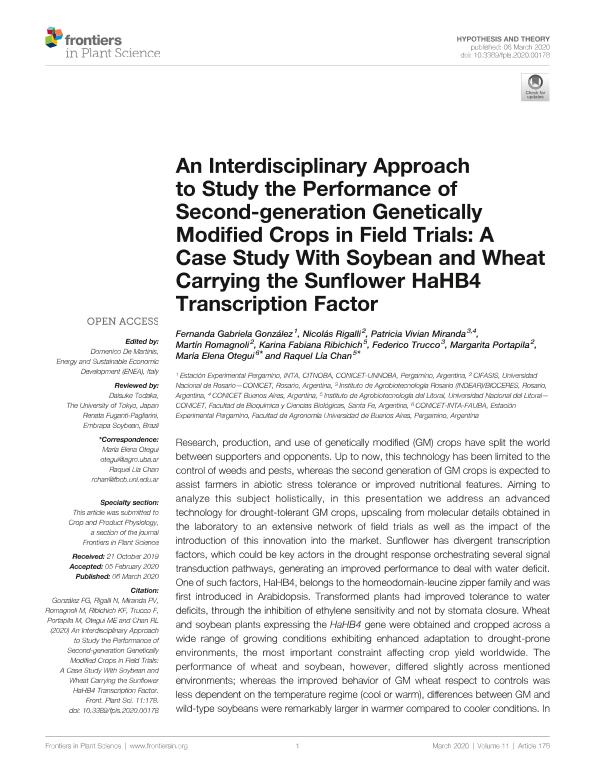Mostrar el registro sencillo del ítem
dc.contributor.author
González, Fernanda Gabriela

dc.contributor.author
Rigalli, Nicolas Francisco

dc.contributor.author
Miranda, Patricia Vivian

dc.contributor.author
Romagnoli, Martín

dc.contributor.author
Ribichich, Karina Fabiana

dc.contributor.author
Trucco, Federico

dc.contributor.author
Portapila, Margarita Isabel

dc.contributor.author
Otegui, Maria Elena

dc.contributor.author
Chan, Raquel Lia

dc.date.available
2021-03-01T18:19:47Z
dc.date.issued
2020-03
dc.identifier.citation
González, Fernanda Gabriela; Rigalli, Nicolas Francisco; Miranda, Patricia Vivian; Romagnoli, Martín; Ribichich, Karina Fabiana; et al.; An Interdisciplinary Approach to Study the Performance of Second-generation Genetically Modified Crops in Field Trials: A Case Study With Soybean and Wheat Carrying the Sunflower HaHB4 Transcription Factor; Frontiers Media S.A.; Frontiers in Plant Science; 11; 3-2020; 1-15
dc.identifier.uri
http://hdl.handle.net/11336/127038
dc.description.abstract
Research, production, and use of genetically modified (GM) crops have split the world between supporters and opponents. Up to now, this technology has been limited to the control of weeds and pests, whereas the second generation of GM crops is expected to assist farmers in abiotic stress tolerance or improved nutritional features. Aiming to analyze this subject holistically, in this presentation we address an advanced technology for drought-tolerant GM crops, upscaling from molecular details obtained in the laboratory to an extensive network of field trials as well as the impact of the introduction of this innovation into the market. Sunflower has divergent transcription factors, which could be key actors in the drought response orchestrating several signal transduction pathways, generating an improved performance to deal with water deficit. One of such factors, HaHB4, belongs to the homeodomain-leucine zipper family and was first introduced in Arabidopsis. Transformed plants had improved tolerance to water deficits, through the inhibition of ethylene sensitivity and not by stomata closure. Wheat and soybean plants expressing the HaHB4 gene were obtained and cropped across a wide range of growing conditions exhibiting enhanced adaptation to drought-prone environments, the most important constraint affecting crop yield worldwide. The performance of wheat and soybean, however, differed slightly across mentioned environments; whereas the improved behavior of GM wheat respect to controls was less dependent on the temperature regime (cool or warm), differences between GM and wild-type soybeans were remarkably larger in warmer compared to cooler conditions. In both species, these GM crops are good candidates to become market products in the near future. In anticipation of consumers’ and other stakeholders’ interest, spectral analyses of field crops have been conducted to differentiate these GM crops from wild type and commercial cultivars. In this paper, the potential impact of the release of such market products is discussed, considering the perspectives of different stakeholders.
dc.format
application/pdf
dc.language.iso
eng
dc.publisher
Frontiers Media S.A.

dc.rights
info:eu-repo/semantics/openAccess
dc.rights.uri
https://creativecommons.org/licenses/by/2.5/ar/
dc.subject
DROUGHT TOLERANCE
dc.subject
GRAIN YIELD DETERMINATION
dc.subject
HAHB4
dc.subject
SUNFLOWER TRANSCRIPTION FACTOR
dc.subject
TRANSGENIC SOYBEAN
dc.subject
TRANSGENIC WHEAT
dc.subject.classification
Tecnología GM, clonación de ganado, selección asistida, diagnósticos, tecnología de producción de biomasa, etc.

dc.subject.classification
Biotecnología Agropecuaria

dc.subject.classification
CIENCIAS AGRÍCOLAS

dc.title
An Interdisciplinary Approach to Study the Performance of Second-generation Genetically Modified Crops in Field Trials: A Case Study With Soybean and Wheat Carrying the Sunflower HaHB4 Transcription Factor
dc.type
info:eu-repo/semantics/article
dc.type
info:ar-repo/semantics/artículo
dc.type
info:eu-repo/semantics/publishedVersion
dc.date.updated
2020-08-05T16:41:51Z
dc.identifier.eissn
1664-462X
dc.journal.volume
11
dc.journal.pagination
1-15
dc.journal.pais
Suiza

dc.journal.ciudad
Lausana
dc.description.fil
Fil: González, Fernanda Gabriela. Consejo Nacional de Investigaciones Científicas y Técnicas. Centro de Investigaciones y Transferencia del Noroeste de la Provincia de Buenos Aires. Universidad Nacional del Noroeste de la Provincia de Buenos Aires. Centro de Investigaciones y Transferencia del Noroeste de la Provincia de Buenos Aires; Argentina. Instituto Nacional de Tecnología Agropecuaria. Centro Regional Buenos Aires Norte. Estación Experimental Agropecuaria Pergamino; Argentina
dc.description.fil
Fil: Rigalli, Nicolas Francisco. Consejo Nacional de Investigaciones Científicas y Técnicas. Centro Científico Tecnológico Conicet - Rosario. Centro Internacional Franco Argentino de Ciencias de la Información y de Sistemas. Universidad Nacional de Rosario. Centro Internacional Franco Argentino de Ciencias de la Información y de Sistemas; Argentina
dc.description.fil
Fil: Miranda, Patricia Vivian. Consejo Nacional de Investigaciones Científicas y Técnicas. Centro Científico Tecnológico Rosario. Instituto de Agrobiotecnología de Rosario; Argentina
dc.description.fil
Fil: Romagnoli, Martín. Consejo Nacional de Investigaciones Científicas y Técnicas. Centro Científico Tecnológico Conicet - Rosario. Centro Internacional Franco Argentino de Ciencias de la Información y de Sistemas. Universidad Nacional de Rosario. Centro Internacional Franco Argentino de Ciencias de la Información y de Sistemas; Argentina
dc.description.fil
Fil: Ribichich, Karina Fabiana. Consejo Nacional de Investigaciones Científicas y Técnicas. Centro Científico Tecnológico Conicet - Santa Fe. Instituto de Agrobiotecnología del Litoral. Universidad Nacional del Litoral. Instituto de Agrobiotecnología del Litoral; Argentina
dc.description.fil
Fil: Trucco, Federico. Consejo Nacional de Investigaciones Científicas y Técnicas. Centro Científico Tecnológico Rosario. Instituto de Agrobiotecnología de Rosario; Argentina
dc.description.fil
Fil: Portapila, Margarita Isabel. Consejo Nacional de Investigaciones Científicas y Técnicas. Centro Científico Tecnológico Conicet - Rosario. Centro Internacional Franco Argentino de Ciencias de la Información y de Sistemas. Universidad Nacional de Rosario. Centro Internacional Franco Argentino de Ciencias de la Información y de Sistemas; Argentina
dc.description.fil
Fil: Otegui, Maria Elena. Consejo Nacional de Investigaciones Científicas y Técnicas; Argentina. Instituto Nacional de Tecnología Agropecuaria; Argentina. Universidad de Buenos Aires. Facultad de Agronomía; Argentina
dc.description.fil
Fil: Chan, Raquel Lia. Consejo Nacional de Investigaciones Científicas y Técnicas. Centro Científico Tecnológico Conicet - Santa Fe. Instituto de Agrobiotecnología del Litoral. Universidad Nacional del Litoral. Instituto de Agrobiotecnología del Litoral; Argentina
dc.journal.title
Frontiers in Plant Science
dc.relation.alternativeid
info:eu-repo/semantics/altIdentifier/url/https://www.frontiersin.org/article/10.3389/fpls.2020.00178/full
dc.relation.alternativeid
info:eu-repo/semantics/altIdentifier/doi/https://doi.org/10.3389/fpls.2020.00178
Archivos asociados
